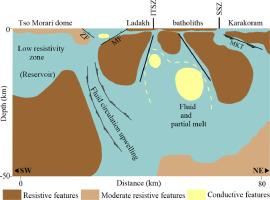The geothermal resources and their connectivity with the deep tectonic are meaningful to understand through their structural geometry in the NW Himalayas. Therefore, over the NW-SE profiles, 23 audio Magnetotelluric (AMT) sites and over the SW-NE profile, 15 broadband Magnetotelluric (BBMT) sites were carefully chosen to provide the detailed structure. The electrical models were produced from a 2-D inversion algorithm based on the non-linear conjugate gradient method. The Chumathang-Mahe and Puga-Sumdo regions offer excellent geothermal potential as heat/fluid passes through the Mahe Fault (MF), Zildat Fault (ZF) and Kiagor Tso Fault (KTF). These faults are well revealed in the electrical models beneath the subsurface. The Puga Valley has an excellent geothermal resource at shallow depth. A ∼1000 m thick sulfide mineral body is defined with high conductivity (∼1 Ω-m). The crustal structure shows a highly conductive mid-crust beneath the Ladakh batholiths with no manifestation roots. The signs of the Indus-Tsangpo Suture Zone (ITSZ) and Shyok Suture Zone (SSZ) are well represented in the crustal model and are associated with the steep-dipping faults. The Chumathang-Mahe and Puga-Sumdo geothermal regions are connected with low resistivity body (C1) at shallow depths in the crustal model along the SW-NE profile and offer a path for deep fluid flow. The frictional heat generated in the process of the Indian plate subducting beneath the Tibetan plateau and the collision zone between India and Asia carried to melt. The high heat surface flow indicates the thermal origin of low resistivity. Thus, a ∼10 sq. km low resistivity reservoir is identified beneath the Tso Morari dome in the crustal model that overlies a resistivity feature. The high conductivity at mid-crust determined at active tectonic fabric may be potential geothermal resources yielding high well-productivity.



